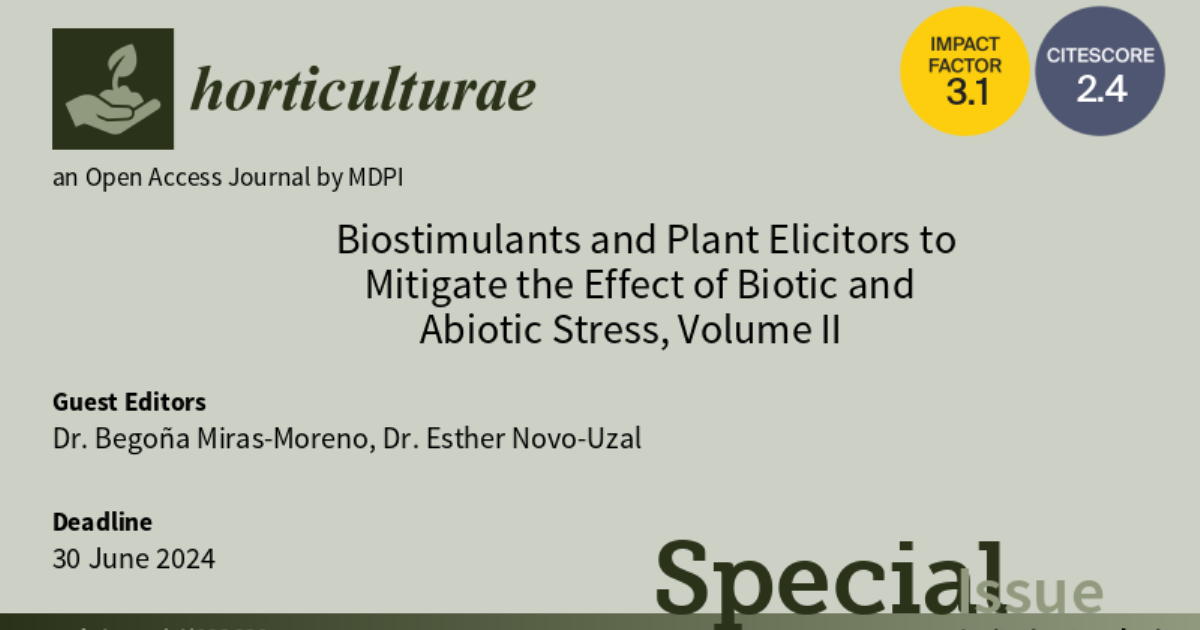Biostimulants and Plant Elicitors to Mitigate the Effect of Biotic and Abiotic Stress, Volume II
A special issue of Horticulturae (ISSN 2311-7524). This special issue belongs to the section "Biotic and Abiotic Stress".
Deadline for manuscript submissions: 30 June 2024 | Viewed by 1165

Special Issue Editors
Interests: abiotic stress; phytohormones; secondary metabolism; biostimulants; plant biochemistry
Special Issues, Collections and Topics in MDPI journals
Interests: abiotic stress; plant biochemistry; plant evolution; oxidative stress; secondary metabolism; RNA regulation
Special Issues, Collections and Topics in MDPI journals
Special Issue Information
Dear Colleagues,
Plant biostimulants are substance(s) and/or microorganisms applied to the plants or the rhizosphere with the aim of enhancing nutrition efficiency or product quality of crops, independently from the plant nutrient content. In the last decade, the use of biostimulants has been on the rise due to the increasing awareness of the need to promote sustainable agriculture worldwide. In addition to their role in enhancing plant performance, biostimulants can also help plants to cope with abiotic stress. Along these lines, it is known that plant elicitors can increase plant tolerance to biotic stresses.
This Special Issue aims to shed light on the morphological, physiological, and biochemical processes triggered by the application of biostimulants and plant elicitors, ultimately leading to an increase in biotic and abiotic stress tolerance. Particular attention will be paid to the mechanisms that can be used to tackle increasingly frequent environmental stresses derived from climate change. We welcome authors to submit studies focused on these issues.
Dr. Begoña Miras-Moreno
Dr. Esther Novo-Uzal
Guest Editors
Manuscript Submission Information
Manuscripts should be submitted online at www.mdpi.com by registering and logging in to this website. Once you are registered, click here to go to the submission form. Manuscripts can be submitted until the deadline. All submissions that pass pre-check are peer-reviewed. Accepted papers will be published continuously in the journal (as soon as accepted) and will be listed together on the special issue website. Research articles, review articles as well as short communications are invited. For planned papers, a title and short abstract (about 100 words) can be sent to the Editorial Office for announcement on this website.
Submitted manuscripts should not have been published previously, nor be under consideration for publication elsewhere (except conference proceedings papers). All manuscripts are thoroughly refereed through a single-blind peer-review process. A guide for authors and other relevant information for submission of manuscripts is available on the Instructions for Authors page. Horticulturae is an international peer-reviewed open access monthly journal published by MDPI.
Please visit the Instructions for Authors page before submitting a manuscript. The Article Processing Charge (APC) for publication in this open access journal is 2200 CHF (Swiss Francs). Submitted papers should be well formatted and use good English. Authors may use MDPI's English editing service prior to publication or during author revisions.
Keywords
- biostimulants
- elicitors
- abiotic stress
- biotic stress
- secondary metabolism
- climate change






